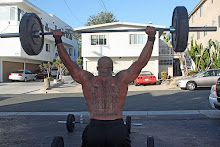
So in my many years of sports, training, and coaching their has been a silent debate over what is agility and how to train it. After some extensive research I think I might be able to define what agility is and how it pertains to human performance in training and sport.
Wikipedia defines agility as: the ability to change the body's position efficiently, and requires the integration of isolated movement skills using a combination of balance, coordination, speed, reflexes, strength, endurance and stamina.
CrossFit defines agility as: the ability to minimize transition time from one movement pattern to another.
I've come to define agility as: the ability to change direction without the loss of speed, strength, or power. The ability to perform fluid changes of movement with the whole body in relation to speed, strength , and power. The ability to move well in any direction in a rapid fashion using speed, strength, and power.
So now that we have defined agility how can we train it so we become more agile in training or sport?
Bio motor Characteristics
1. Relative body strength- most important- If the athlete is not strong enough for their body weight, it is impossible for him/her to be agile.
2. Speed- whether it be lateral or straight line.
3. Motor Coordination(timing)
4. Balance(stability)
5. Motor Programs(technique)
Approach to Agility Training
- Acceleration
- Deceleration
- Stopping
- Re-acceleration
- Conditioning
- Injury Prevention
Pre-conditioning for Agility Training
- Base of Support: Base of support(BOS)is critical for balance, stability, and proper change of direction. Trainers must be able to identify weaknesses in clients BOS stance during training.
- Center of Gravity: Keep the center of gravity(COG) closer to the base of support to increase stability and the opportunity to change direction. Trainer must be able to assess the relationship of the COG and BOS during athletes change of direction technique.
- Muscle Force Vectors: The direction of the muscle force vectors(MFV) will influence the direction and quality of change of direction movements. The trainer must address the relationship between COG, BOS, and the MFV during agility training.
The Formula for Agility Training
- Acceleration: is the increase in speed in any direction. This movement involves concentric contraction. COG must move away from BOS in direction of movement. This action will set the muscle force vectors in the correct alignment.
- Deceleration: is the decrease of speed in any direction. This movement involves the eccentric contraction. COG must move closer to and behind the BOS in the direction of movement. This action will allow for the proper force reductions contractions to occur.
- Stopping: is a brief absences of movement in any direction. Involves the isometric contraction. COG is stopped in a position over the BOS that sets up the re-acceleration. This action will allow the proper balance and change of direction to occur.
- Conditioning: Agility training is an excellent anaerobic condition tool. Trainers must control quality and proper rest periods during training. This will allow athletes to develop their hearts, lungs, mitochondria, and capillaries over time.
- Injury Prevention: athletes must develop adequate bio motor requirements for agility training( relative body strength, speed, timing, stability, and technique). Trainers can not progress to levels of training that the athlete are not prepared for.
Tomorrow I will cover some drills that will increase your agility in sport and training. These drills will cover acceleration, deceleration, and overall conditioning.



No comments:
Post a Comment